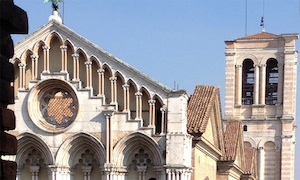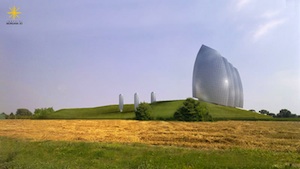Geothermal and waste energy sources
Ferrara, City of the Renaissance, and its Po Delta, with an area of 46,712 ha, was inscribed on the World Heritage List in 1995. The humanist concept of the ‘ideal city’ came to life here in the neighbourhoods built from 1492 onwards by Biagio Rossetti according to the new principles of perspective. The completion of this project marked the birth of modern town planning and influenced its subsequent development. Today Ferrara continues in this creative spirit in such fields as energy.
Ferrara is one of the most sustainable cities of Italy and environmental issues are seriously taken into account by the Municipality. It subscribed the Aalborg chart in 1996 y en la 1998 comenzó la Agenda Local 21 proceso. It has also been awarded by Legambiente (la agencia ambiental italiana) como la ciudad con el medio ambiente en 2001. The municipality is member of several Italian and European networks of sustainable cities (ICLEI, BigNet, and Car Free Cities) and is signatory of EU’s Covenant of Mayors.
The Geothermal Project
The use of geothermal energy as energy source starts with its discovery in 1956, during explorations for oil reservoirs at a depth of 1,000 m, 4 km NO del centro de la ciudad de Ferrara. At that time the well was abandoned and only after the energy crisis of the 70’s it was taken again into account, to utilize this important energy source.
Recent geo-structural and geothermal investigations carried out by HERA Group (Energy Resources Environment Holdings) in collaboration with the University of Ferrara and the Emilia-Romagna Region, confirm the presence of geothermal reservoirs in the east part of Ferrara. Three hydrothermal systems have been identified. Each reservoir can be considered hydraulically separated from the others by aquitards that prevent significant leakages.
At the beginning of the 80’s, the Municipality of Ferrara developed a Geothermal Project in order to exploit this resource as a primary source for an urban heating system and to reduce, in a solid way, the environmental impact created by the traditional energy sources (coke, oil and methane gas, etc…).
Al principio, el fluido geotérmico (agua caliente, ca 100°C) se bombea desde las profundidades de 1,000 m a la superficie; a continuación, el agua caliente transfiere energía térmica para el sistema de calefacción. Finalmente, que se reintroduce en el subsuelo con el fin de garantizar la estabilidad geotécnica.
Las obras comenzaron en 1987 y en la 1990 los primeros edificios fueron conectados a la red de calefacción urbana. En 1993 la planta de cogeneración para la termo-destrucción de los desechos sólidos se construyó, mientras que un segundo pozo fue abierto en 1995. En 1999 se ha instalado un alternador de turbo alimentado con el vapor generado por la planta de cogeneración. At the end of 2010 the installed geothermal power was about 23 MWt.
Sistema Integrado de Energía
Ahora, la red en Ferrara se alimenta con el llamado "sistema de energía integrado", because the energy from the Waste Treatment Plant was added to the geothermal source. Este sistema tiene más beneficios ambientales y económicos que la vez tradicional ya que permite tener un ahorro significativo de costes y reducir las emisiones de CO2.
The system incorporates geothermal sources, CHP (combined heat and power) units installed in the solid waste processing plants, together with boilers running on biogas and used as backup systems. The urban heating network supplies the equivalent of 22,000 housing units, mostly in private and public buildings.
But the future is more promising. The proposed new Renewable Energy Hub will allow increasing this figure to 37,000 housing units, meaning that the district heating would cover the 40% of households. Another new development is that solar thermal will be incorporated to geothermal, with the capacity to convert solar energy into thermal energy for heating with a power of 1 MWt.
The energy mix will reach 90% of renewables. With the new Hub, 56.4% of the energy in the grid will come from geothermal sources, 34.3% from the Cassana incinerator, exploiting energy from waste and agricultural biomass, 0.3% from solar thermal, and only 9% from natural gas, the only non-renewable source.
Lessons learned and replicability
The District Heating System of Ferrara represents one of the most important examples of ‘Integrated Energy System’ that will be further increased by the future development. Debido a su alta eficiencia energética este sistema se piensa que es muy aconsejable y transferible aunque algunos problema puede estar relacionado con el tamaño de construcción requerido, relacionados con el mercado, y razones económicas y técnicas.


















